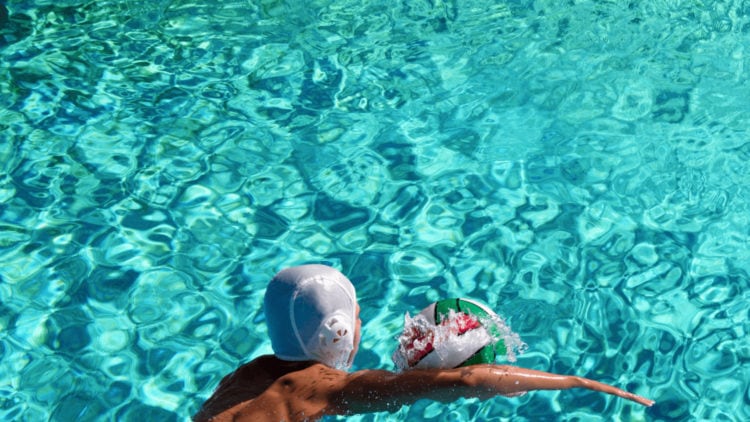
OBJECTIVE OF WATER POLO: Score points by throwing the water polo ball into the opposing team’s goal.
NUMBER OF PLAYERS: 14 players, 7 on each team
MATERIALS: Water polo ball, 2 water polo goals, 1 pair of goggles per player, 1 water polo cap per player
TYPE OF GAME: Sport
AUDIENCE: 8+
OVERVIEW OF WATER POLO
Water polo is a unique sport in which players constantly tread water throughout the game. The game originated in the mid-1800s and has had a lot of rule changes since its inception. Sometimes referred to as “basketball in water,” water polo is a very fast-paced sport that is fun to watch and requires a lot of athletic ability to play.
SETUP
Pool
A water polo pool is around 65 feet wide and 6.5 feet deep. In men’s water polo, the pool is 98 feet long; in women’s water polo, the pool is 82 feet long. There is a line across the bottom of the pool directly in the center. There are also floating buoys marking the boundary of play. The goals are nearly 3 feet tall, 9 feet wide, and 3.6 feet deep.
Players

There are seven players on each water polo team: 6 fielders and one goalie.
Goalie: The goalie rarely moves more than 5 meters away from the goal. They are the main defending player.
Center Forward: The lead offensive player in a water polo game and generally the player that scores the most points.
Left/right wing: These are hybrid players who will defend the goal as well as move downfield to open up scoring opportunities. They must be fast and strong as they cover a lot of ground.
Left/right driver: These are primarily offensive players who assist the center forward by gaining possession of the ball and passing it down the pool. They must also be quick and able to drop back and defend if necessary.
Point: The point is another very important offensive player that generally plays nearest to the opposing team’s goal. They are in charge of blocking, passing the ball, scoring, and defending. The point must have a very versatile skillset.
GAMEPLAY

A water polo game starts with the ball directly in the center of the pool and all players in their respective positions. The referee will blow a whistle, and the players will move fast to gain possession of the ball.
Water polo games are divided into 4 quarters, each 8 minutes long, for a total of 32 minutes. The clock runs continuously throughout the game and only stops for fouls, penalties, or if the ball goes out of bounds. There is also 2-minute break between the 1st and 2nd and 3rd and 4th quarters and a 10-minute break between the 2nd and 3rd quarters.
Passing
Players can only touch the ball with one hand in water polo. The only exception to this rule is if the goalie is within 6 meters (20 feet) from the goal. Players are not allowed to touch the bottom of the pool and must tread water throughout the entire game. The ball can be passed forward, backward, or side to side.
Players can also “dribble” the ball to advance it. To dribble the ball in water polo, a player swims with the ball directly in front of them. The ball will go forward as the player strokes the water.
Scoring
If a player throws the ball through the opposing team’s goal, their team will be awarded one point. The defending team can block the attempted shots, intercept the ball, and guard the player making the shot. Defenders are allowed to touch offensive players in water polo as long as they are not obstructing their movement, dunking them in the water, or holding them.
The goal counts as long as the ball passes the goal line. This means that even if the goalie blocks the shot, but the ball passes the goal line, the offensive team still scores a point.
Shot clock
The shot clock is an important part of water polo that keeps the game fast-paced. Similar to the basketball shot clock, the offensive team has a limited time they are allowed possession of the ball. The offensive team has 35 seconds to score a point or attempt to shoot the ball through the goal.
If they attempt to score, but the ball bounces off the goal, and the offensive team regains possession from the rebound, the shot clock resets. If they fail to score or shoot in the 35-second time limit, possession of the ball is handed over to the opposing team.
Fouls
There are several fouls in water polo that will either result in the ball being turned over to the other team, a player being temporarily or permanently ejected from the game, or a penalty throw.
Here are some of the common fouls and penalties in water polo:
- Touching the ball with both hands
- Touching the bottom of the pool
- Failing to shoot the ball within the shot clock
- Sinking or holding an opponent
- Blocking a free throw
END OF GAME
At the end of the fourth quarter, the team with the highest score wins the game. If the score is tied at the end of the fourth quarter, the game goes to a shootout period to determine the winner. During a shootout, 5 players on each team will take individual free shots at the goal with the goalie blocking. After both teams have gone, the team with the highest score wins. If the score is still tied after the shootout, the teams move to a sudden death shootout, where the first team to score wins.
- 30 GAMES TO PLAY OVER TEXT - April 22, 2024
- 20+ FREE PRINTABLE BABY SHOWER GAMES - April 16, 2024
- 20+ College Party Games for the Best Night Ever! - April 2, 2024